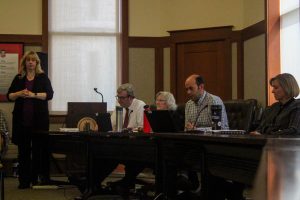Are Soviets trying on new American image?
July 12, 1988
I had this prophetic dream a few months ago: Soviet leader Mikhail Gorbachev asked President Reagan during May’s Moscow summit for a dozen pairs of Levis 501 jeans … wholesale. Gorbachev wanted them mailed directly to him from the American company to avoid the exorbitant Russian black market costs. (It seems he’d been impressed with those ultra-hip button fly ads he’d seen on MTV.)
I awoke from this terrifying dream in a cold sweat. What could it mean? Cheap jeans and a new image for Gorbachev? Competition among other communist country leaders for good deals on imported Western paraphernalia? Or the impending “democratic” restructuring of the Soviet’s governmental system?
Of course, time proved the latter to be true. The world has watched with wonder as Soviet reform leaders, led by Gorbachev, proposed change after radical change in governmental policy and system during the recent All-Union Communist Party Conference. All the proposed alterations are part of Gorbachev’s program of perestroika, or restructuring.
Simply calling the conference into session was a radical move in and of itself. This was the Soviet Communist Party’s first general conference in 47 years, since the days of Stalin. Most conference delegates knew they should expect a few liberal suggestions for administrative change—Gorbachev has been known as a relatively radical leader since his coming to power in 1985. But few people, within and outside of the Soviet Union, probably had any idea how far-reaching the reform recommendations would be.
A sample: Separation of powers within the party. A newly strengthened legislature and presidency. Limitations of 10-year terms of office. Qualification reviews for 20 million party members.
Of course these remain at present just suggestions, but Gorbachev has a solid base of support in the Politburo and the upper echelons of Soviet government. It could be only a few years before these radical new reform ideas become a reality.
Proposals for governmental change aren’t the only surprises coming from the Soviet Union these days. For example, the USSR pulled its military forces out of Afghanistan after eight years of occupation.
But perhaps the biggest shock for the Western world was to see Soviet dissidents on TV actually protesting publicly—in the land of KGB, codes of silence and dissident suppression!
Sure seems like the USSR is trying to “turn American” and finally grab a piece of the democratic pie, huh? Could Gorbachev be trying on his Levis?
Odds are really against it. One Communist Party official told U.S. House Speaker Jim Wright on a CNN special newscast three weeks ago that the Soviet Union really isn’t taking the bastion of Western democracy as its blueprint in perestroika. He said that although many Americans may be rejoicing that the USSR is following their 212-year-old lead, the Soviet effort is an entirely independent undertaking.
Another misconception held by some Americans is that the Cold War has finally come to an end after 40 years. After all, the model of Communism in the East is getting soft on their hardline commie-pinko slant, right?
The war might be lukewarm now, but it is, unfortunately, not over. However, recent developments such as the Intermediate-Range Nuclear Forces Treaty of last December and May’s cordial (if do-nothing) superpower summit could be important steps towards a more conciliatory relationship with our counterpart superpower.
Americans should appreciate the gravity of Gorbachev’s reforms. Those protesting dissidents must have a true sense of appreciation for their brief taste of freedom. The name of our political game is supposed to be human liberty, and what better way could there be to renew our belief in its value than by observing its growth within a country so formerly suppressive as the USSR?






